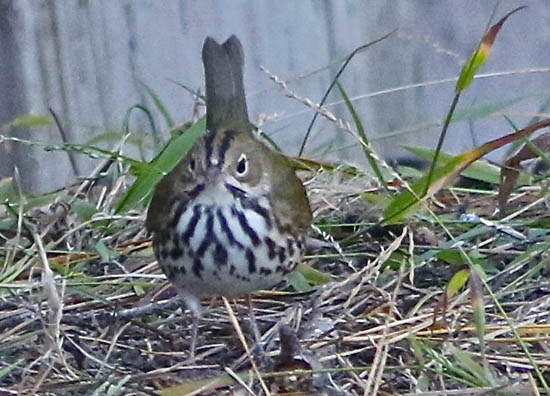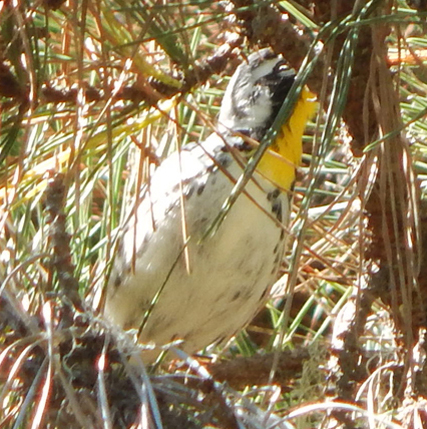| These highlights chronicle the year 2019. The year runs generally "backwards" on this page. Unlike earlier years, this update includes fewer highlights over a longer period. The abbreviation "MTY" means "Monterey County" in the text below. Text by Don Roberson. Photos on this page are copyrighted by the photographers to whom they are attributed, and may not be reproduced in any form (including other web sites) without the express consent of the photographer. | ||||
|
||||
|
||||
| So far all the crossbills tape-recorded in MTY this autumn has been "type 2" [Ponderosa Pine crossbills]. There are up to 10 "types" of Red Crossbills in North America (and even more in the Old World) which may be incipient species. These populations tend to forage primarily on specific conifers within resident ranges, but when there is a poor crop of their preferred cones, crossbills can appear far from their 'home' ranges. In fall 2012, winter 2014-15, and winter 2017-18, the incursions were composed of "type 3" Red Crossbills [Western Hemlock crossbills], presumable originating from northwestern North America. This year's event of "type 2" crossbills have been documented in various past irruptions (e.g., 1987-88, 1996-97). Their strong "kip-kip-kip" calls can remind local birders of their interactions with crossbills in Yosemite, where "type 2" crossbills breed annually. | ||||
On 1 November, Monterey Audubon's annual "Pt. Pinos Seawatch" began for its 5th consecutive year. Our professional counter in 2019 is John Garrett (right, staring at a rather calm Monterey Bay, which was typical in early November; © D. Roberson). The Seawatch continues dawn to dusk daily from 1 Nov-15 December, and visitors at the Point are welcome. Seawatch highlights will likely appear in more recent updates, but unexpected birds in early November included Short-eared Owl and Lapland Longspur at the Point. |
||||
On
Sunday, 27 Oct, Michael Rieser glimpsed a small brown warbler in the
undergrowth that was giving a call-note that sounded like Fox Sparrow
at a limited access location in the Yankee Point vicinity. In
discussing the situation that day with others, it was suggested that
"Dusky Warbler" might fit that call-note, but efforts to relocate the
bird that day were unsuccessful. This is just the second record for MTY: one was banded by Big Sur Ornithology Lab at Andrew Molera SP on 2 Oct 2004 (photo below © Jessica Griffiths, BSOL).
Dusky Warbler is a long-distance migrant from its breeding grounds in northeastern Asia to its wintering grounds in the tropics of south and southeast Asia. Vagrants have reached most countries in Europe — there were already more than 50 records from Britain when Rare Birds in Britain & Ireland, 2d ed., was published 30 years ago. That book stated that nearly all records were between Sep-Nov, and mentioned its "skulking" behavior and its "tak" call (Dymond et al. 1989). In California there are now about 20 records, all between late Sep and early Nov. The nearest to MTY were at Antonelli Pond, Santa Cruz Co., in mid-Oct 1997 and in mid-Oct 2008. |
||||
|
||||
By the middle of October 2019 it was apparent that the warblers that characterized late September were gone. Mark Chappell photographed this lovely hatch-year Black-and-white Warbler at Big Sur R. mouth on 12 Oct (photo below left, © Mark Chappell) but the best of the eastern vagrant warblers this fall may have passed through earlier (see bottom of this page for a couple of examples). Black-and-white, though, has been in very small numbers this autumn. What did arrive in huge numbers of Sunday, 13 October, were Cackling Geese — the vast majority of which were Aleutian Cackling Geese Branta hutchinsii leucopareia. In the early morning a boatload of birders a mile west of Pt. Pinos spotted a huge phalanx of fast-traveling geese heading for them from the south. As the wave of vocalizing geese passed between them and the morning sun, a photographer aboard captured the "head of the V" (below right, © Carole Rose). They were estimated by 50s at 400 geese [I count 77 in her shot. The size of a couple of them may suggest a few minima among the flock, or may be an optical illusion]. On-shore observers within the next hour had another 110 passing Pt. Pinos and over 60 at the Carmel R. mouth; more were at Moss Landing later. Still more were passing over Pacific Grove at dusk. A minimum of 600 Aleutians — and likely more — were on the move northwards on 13 Oct, recalling the mighty flight of at least 688 in multiple flocks on 4 Oct 2017 [see near middle of fall 2017 page]. As noted there, "the occurrences might suggest that flocks migrating south from Alaska became lost over the sea (due to fog?) and had to return northward to reach the intended winter locales. The numbers also illustrate the extent of the Aleutian Goose's impressive comeback from Endangered status just a half-century ago." |
||||
|
||||
Long-time MTY observers are accustomed to seeing a few Pacific Golden-Plovers in two patterns: a very few dazzling gold-spangled juvs in fall migration, and later, more subdued, but still yellow-faced and gold-backed plovers that may winter on coastal headlands, coastal artichoke fields after harvest, or occasionally among flocks of Black-bellied Plovers on rocky shorelines. On 12 Oct, Matthew Dodder and his Bay Area bird class found a golden-plover on the sandy dunes of Moss Landing SB that was problematic. It was not very "golden" and to some, at least, it appeared long-winged, recalling American Golden-Plover. Various observers thought it "confusing," "not typical of either species," or "a tough i.d." Complicating the problem was that photos from different cameras and different backgrounds produced images that differed from each other. Here are a couple of examples — left-hand photo 12 Oct © Don Roberson; right-hand photo 12 Oct © Bill Hubick: |
||||
|
||||
In early October there were a string of "one-day-wonders" — basically every rarity from here to the bottom of the page! — and among these was this small flycatcher (left © John Mendoza). It was photographed at the Big Sur River lagoon on 6 October by Mendoza, visiting from San Luis Obispo Co. Review of a series of photos that evening by experts revealed it as a hatch-year female Vermilion Flycatcher! This is the second Vermilion Flycatcher in MTY in 2019, following the male in June at the old Rancho Cañada golf course, and is just the 13th ever in the county. |
||||
This is the 20th Gray Flycatcher in MTY but only the second in fall migration. The only prior fall migrant was at Big Sur R. mouth on 10-12 Sep 2015. That fall migrant, and a spring migrant in Apr 2006, are the only Gray Flycatchers to stay for more than one day. So this elusive Empid remains, for most, in the category that it is best to find your own! |
||||
... and the previous week .... |
||||
|
||||
The turn of October brought a series of major rarities, each of which proved to be very elusive. On Tuesday, 1 Oct, Ryan Terrill documented two Chimney Swift with 30 Vaux's Swift, in a big migrant flock that included 45 White-throated Swift, over the parking lot of Andrew Molera SP on the Big Sur coast. No swifts were present there the next day. Chimney Swift remains a significant rarity locally, with most records in summer around the Big Sur R. mouth at Andrew Molera SP. There is a prior late August record of a fall migrant (see Roberson 2002) but these Chimney Swifts are among the latest in California, with fall migrants concluded by about 10 Oct (CBRC 2007). The identification of Chimney Swift can be perilous but is much improved if seen adjacent to Vaux's Swift (as in this case) or if the swifts are vocalizing. On Wednesday, 2 Oct, Teale Fristoe — visiting from Berkeley — found a Yellow-throated Warbler
at El Carmelo Cemetery in Pacific Grove, but it was active and flitty,
and Teale snapped just one recognizable photo (above left, © Teale
Fristoe) before it flew off towards the northwest. Don Glasco was with
Teale and texted news of this great rarity, and many searched during
that Tuesday — from Pt. Pinos to Esplanade — but it was not refound.
More were searching again on Thursday morning, 3 Oct. One of those was
Don Roberson — who decided at the last moment to double-check the very
same Myoporum bush in which the warbler had been initially
discovered the day before — and essentially the first bird seen was the
Yellow-throated Warbler again! Don got off a few shots (above right and
below, photos 3 Oct © D. Roberson) before getting on the iPhone to
alert others. And while he did that, the warbler again took off and
disappeared, never to be seen again, to the disappointment of many. |
||||
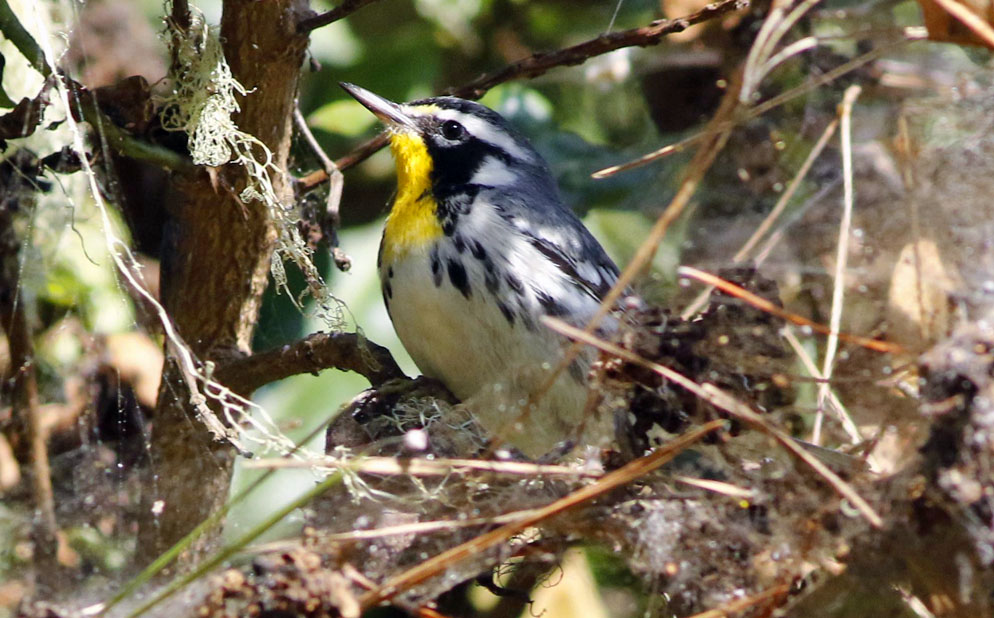 |
||||
Literature cited:
|
||||
|
|
||||
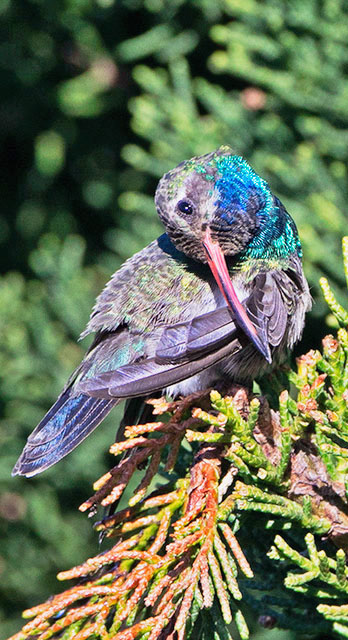
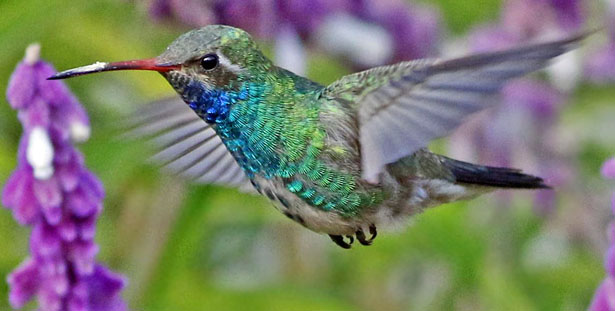
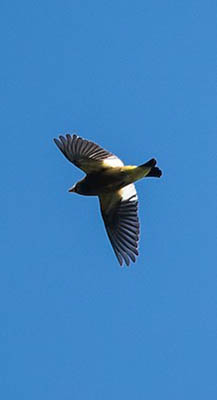
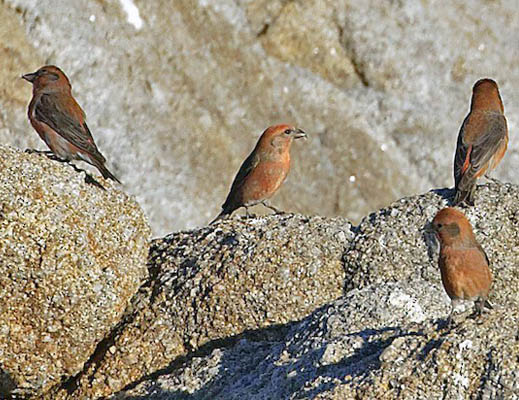
 The suggestion was forwarded to a few locals who, indeed, refound the bird — which proved to be a Dusky Warbler Phylloscopus furcatus —
shortly after dawn the next day. This "Old World Warbler," now in the
family Phylloscopidae, remained characteristically secretive throughout
Monday [photo left 28 Oct © Blake T. Matheson]. It did, however,
make a few forays into a thick willow canopy, especially near dusk. And
then it was gone.
The suggestion was forwarded to a few locals who, indeed, refound the bird — which proved to be a Dusky Warbler Phylloscopus furcatus —
shortly after dawn the next day. This "Old World Warbler," now in the
family Phylloscopidae, remained characteristically secretive throughout
Monday [photo left 28 Oct © Blake T. Matheson]. It did, however,
make a few forays into a thick willow canopy, especially near dusk. And
then it was gone. 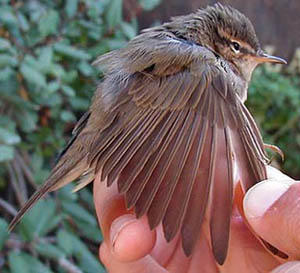
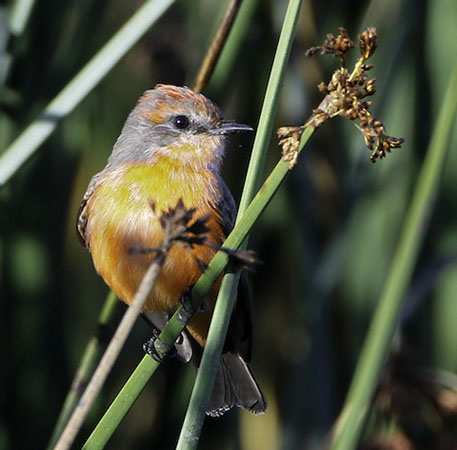 By
late October there had already been two Vermilion Flycatchers recorded
in MTY during 2019. Then Mark Kudrav discovered a third Vermilion Flycatcher
at Pt. Pinos on 25 Oct: a young male showing much orange and red in its
plumage! It remained only to 26 Oct, frequenting the reedy edge to
Crespi Pond (photo left © Bill Hill). Only one Vermilion had
occurred before at well-worked Pt. Pinos — a female in Nov 2012, found
by Bill Hill (more details on the
By
late October there had already been two Vermilion Flycatchers recorded
in MTY during 2019. Then Mark Kudrav discovered a third Vermilion Flycatcher
at Pt. Pinos on 25 Oct: a young male showing much orange and red in its
plumage! It remained only to 26 Oct, frequenting the reedy edge to
Crespi Pond (photo left © Bill Hill). Only one Vermilion had
occurred before at well-worked Pt. Pinos — a female in Nov 2012, found
by Bill Hill (more details on the 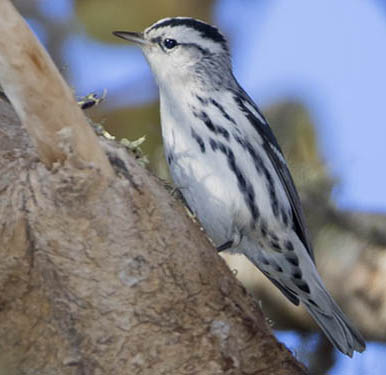

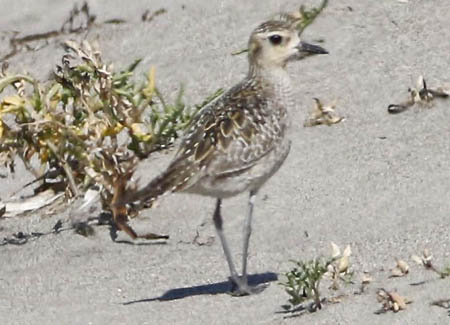
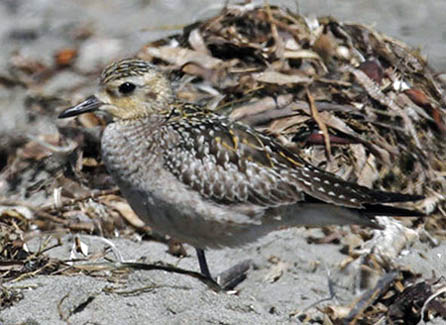
 In
the photos above, the right-hand photo shows a plover with more yellow
in the face than the left-hand bird shows. Is this a difference in
cameras or color saturation? Or was the left side of the face actually
yellower than the right side of the face? Both photos show rather long
bills, an isolated ear patch, and the left-hand shot shows rather long
legs. These tend to be characters of Pacific Golden-Plover.
In
the photos above, the right-hand photo shows a plover with more yellow
in the face than the left-hand bird shows. Is this a difference in
cameras or color saturation? Or was the left side of the face actually
yellower than the right side of the face? Both photos show rather long
bills, an isolated ear patch, and the left-hand shot shows rather long
legs. These tend to be characters of Pacific Golden-Plover.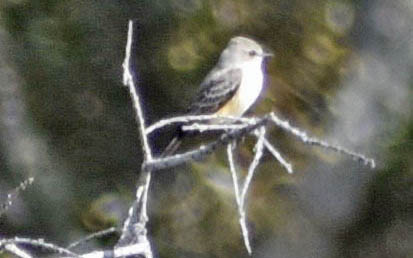
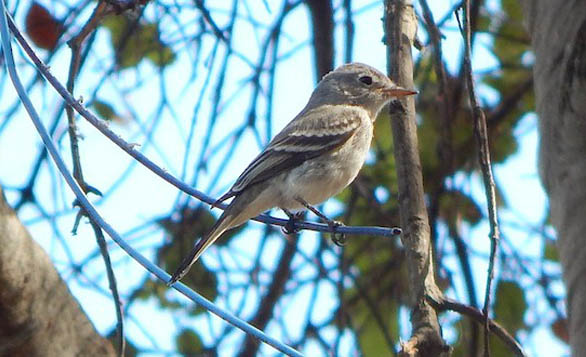 And
then there was yet another rare flycatcher that was a
"five-minute-wonder" on Sunday, 6 Oct — this time at the east end of
Laguna Grande Park in Seaside. Ralph Baker and Dale Swanberg, visiting
from Modesto County, discovered this Gray Flycatcher
(right, © Ralph Baker). They obtained photos and a video that
showed it dipping its tail downwards regularly. Word did not reach
local birders immediately and though there was a "chase" over the rest
of the day, it was not refound.
And
then there was yet another rare flycatcher that was a
"five-minute-wonder" on Sunday, 6 Oct — this time at the east end of
Laguna Grande Park in Seaside. Ralph Baker and Dale Swanberg, visiting
from Modesto County, discovered this Gray Flycatcher
(right, © Ralph Baker). They obtained photos and a video that
showed it dipping its tail downwards regularly. Word did not reach
local birders immediately and though there was a "chase" over the rest
of the day, it was not refound. 